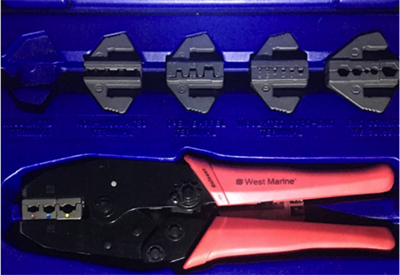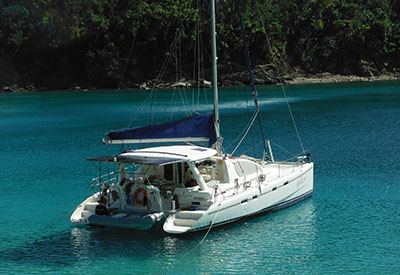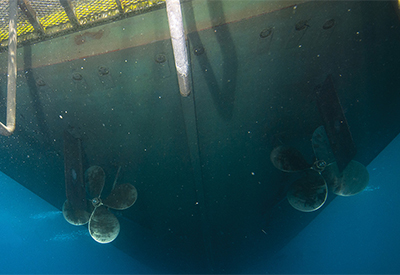Boat Nerd: More Improvements to Our Winter Retreat

What are some of the improvements we’ve made to our Leopard 43, Peregrine? Last time, we took a look at the high output alternators we installed; this time, our new watermaker.
Aug 23, 2023
By Mike Wheatstone
Our Leopard 43 winter retreat in St Maarten
What are some of the improvements we’ve made to our Leopard 43, Peregrine? Last time, we took a look at the high output alternators we installed; this time, our new watermaker.
While water is available on the Caribbean islands we visit, it’s not always convenient to up anchor and move to where one can get water especially if there is a longer distance or a bridge lift involved. Having the capability to produce our own water has several advantages:
• Convenience
• Don’t need to keep the bow mounted 200G water tanks full resulting in less weight up front.
• Less stressing about water usage especially when laundry or boat washing is considered.
We are a 12V DC based boat with no generator. Initially I tried a watermaker with a high pressure pump powered by a 1HP DC motor. As this drew 80A it was only used when at least one engine was running to support the current draw. The system was noisy and the pressure regulating valve needed continuous babysitting as the working pressure of 800 PSI would drift up and down. I was not overly happy with this system.
Other boats we were familiar with had Spectra or Schenker systems using an energy recovery pump intensifier which were much more energy efficient and quieter. These systems use a low pressure feed pump to drive a Clark pump to produce the 800PSI necessary for reverse osmosis to occur while consuming only about a quarter of the energy of a conventional high pressure system. However, they can also be fairly expensive being in the range of US$5,800-$14,000 depending on features and capacity.
 boost pump, motor and flush controller
boost pump, motor and flush controller
In discussions with Electromaax in 2020 I learned they were working with David Smith, one of the original developers of the Clark pump, on an enhanced version of the Clark pump. They reworked portions of the pump lengthening the piston, eliminating bends in the return tubes and replacing plastic and stainless steel elements with titanium versions, resulting in less noise and vibration.
Combined with a 21” RO membrane their system produces 10GPH at a draw of 10A @12V in a compact and light weight package. The price was US$4,900.00.
 energy recovery/intensifier pump and RO tube assembly
energy recovery/intensifier pump and RO tube assembly
In discussions with Electromaax in 2020 I learned they were working with David Smith, one of the original developers of the Clark pump, on an enhanced version of the Clark pump. They reworked portions of the pump lengthening the piston, eliminating bends in the return tubes and replacing plastic and stainless steel elements with titanium versions, resulting in less noise and vibration.
Combined with a 21” RO membrane their system produces 10GPH at a draw of 10A @12V in a compact and light weight package. The price was US$4900.
 the components installed on Peregrine
the components installed on Peregrine
I opted to get one of their new systems which I installed this past winter. It is indeed much quieter than the previous system and does not require system pressure babysitting. Even though there may be systems producing more water per hour, with the much reduced power consumption, running the watermaker for several hours during the day is not an issue. As watermakers like to be run often, running ours every couple of days meets our modest water needs.
Electromaax is nearing completion on an electronics package that can be fitted to their water makers to convert them from strictly
manual operation to pushbutton operation. If the electronics should ever fail, the watermaker can still be run in manual mode. I’ll be investigating adding this electronics package to our system.
If you have questions or comments, please let me know. I’m also always looking for new topics for this column so suggestions are welcome. In the meantime, I wish you good sailing and fair seas!
 CYOB’s Boat Nerd, Mike Wheatstone, has enjoyed sailing since he was in his mid teens. A Queen’s electrical engineer by training, he spent his career working for Ontario Hydro and Hydro One. There he worked in engineering supporting the power system control centres.
CYOB’s Boat Nerd, Mike Wheatstone, has enjoyed sailing since he was in his mid teens. A Queen’s electrical engineer by training, he spent his career working for Ontario Hydro and Hydro One. There he worked in engineering supporting the power system control centres.
His first boat in 1980 was a Shark. With a growing family’s 2-foot-itis, there were upgrades to a Grampian 26, CS34 and currently a Hunter36. Now retired, Mike and his family spend summers on the Hunter (Dragonfyre) and winters in the Caribbean on their Leopard 43 cat (Peregrine).





























